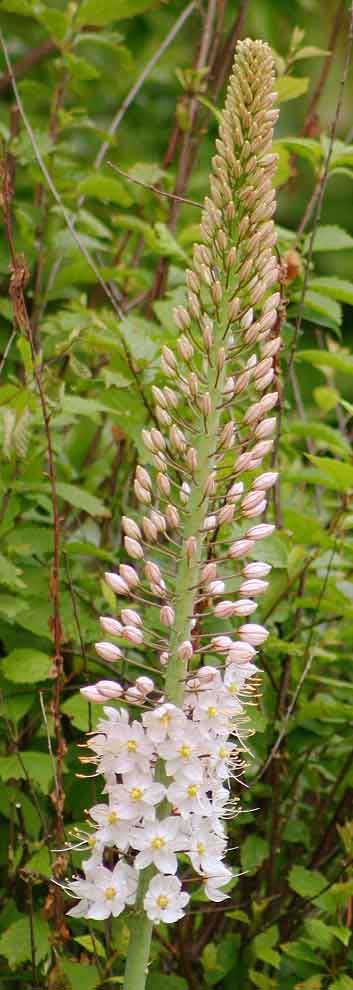
Eremurus robustus (*)
Classification System: APG IV
Superregnum: Eukaryota
Regnum: Plantae
Cladus: Angiosperms
Cladus: Monocots
Ordo: Asparagales
Familia: Asphodelaceae
Subfamilia: Asphodeloideae
Genus: Eremurus
Species: Eremurus robustus
Name
Eremurus robustus Regel, Gartenflora 22: 257 (1873).
Synonyms
Basionym
Henningia robusta Regel, Bull. Soc. Imp. Naturalistes Moscou 41(1): 457 (1868).
Distribution
Native distribution areas:
Continental: Asie
Regional: Central Asie
Kazakhstan; Kirgizstan; Tadzhikistan; Uzbekistan
References: Brummitt, R.K. 2001. TDWG – World Geographical Scheme for Recording Plant Distributions, 2nd Edition
References
Regel, E.A. von, 1873. Gartenflora. Monatschrift für deutsche und schweizerische Garten und Blumenkunde Herausgegeben von E. Regel. Erlangen 22:257, t. 769.
Links
Govaerts, R. et al. 2019. Eremurus robustus in Kew Science Plants of the World online. The Board of Trustees of the Royal Botanic Gardens, Kew. Published online. Accessed: 2019 Feb. 24. Reference page.
International Plant Names Index. 2019. Eremurus robustus. Published online. Accessed: Feb. 24 2019.
The Plant List 2013. Eremurus robustus in The Plant List Version 1.1. Published online. Accessed: 2019 Feb. 24.
Tropicos.org 2019. Eremurus robustus. Missouri Botanical Garden. Published online. Accessed: 24 Feb. 2019.
USDA, ARS, Germplasm Resources Information Network. Eremurus robustus in the Germplasm Resources Information Network (GRIN), U.S. Department of Agriculture Agricultural Research Service. Accessed: 08-Apr-12.
Vernacular names
suomi: Jättimarskinlilja
Eremurus robustus, the foxtail lily or giant desert candle, is a species of flowering plant in the asphodel family, native to the Tien Shan and Pamir Mountains in central Asia that is often used as an ornamental plant.
It is a very tall, narrow plant with a stem 6–10 ft (1.8–3.0 m) high, and leaves as long as 48 in (120 cm) and 4 in (10 cm) wide, the widest in its genus. The deciduous leaves can vary from a bright green to a bluish-green in color. The inflorescence grows to 4 ft (1.2 m) in length and is covered with many deep to pale pink or white flowers, 4 cm (1.6 in) across. At the base of the flower is a brown blotch with a green keel.[1] The lower flowers have long pedicels, with shorter ones higher up. The flowers, as many as 700 to 800 of them, bloom in June.[2] By the time of flowering, the leaves will usually have already shrivelled.
The Latin specific epithet robustus means “sturdy, growing strongly”.[3]
The plant was introduced from Central Asia to Europe and North America in 1874 and is popular in gardens.[4] However some may find the plant to be too tall for normal gardens.[5] It prefers sandy, well-drained soil and full sun.
In cultivation in the UK this plant has gained the Royal Horticultural Society’s Award of Garden Merit.[6][7]
Notes
Thomas, Graham Stuart (June 1, 2005). Perennial Garden Plants. frances lincoln ltd. ISBN 0-7112-2403-X. p. 160.
Royal Horticultural Society 2006. Eremurus robustus Archived 2006-09-11 at the Wayback Machine. Retrieved on October 6, 2006.
Harrison, Lorraine (2012). RHS Latin for Gardeners. United Kingdom: Mitchell Beazley. ISBN 978-1845337315.
Bryan, John E (June 7, 2002). Bulbs. Timber Press. ISBN 0-88192-529-2. p. 222.
Hessayon, D G (December 31, 1995). The Bulb Expert. Sterling Publishing Company, Inc. ISBN 0-903505-42-8. p. 38.
"RHS Plantfinder - Eremurus robustus". Retrieved 16 February 2018.
"AGM Plants - Ornamental" (PDF). Royal Horticultural Society. July 2017. p. 35. Retrieved 16 February 2018.
References
Pink, A. (2004). Gardening for the Million. Project Gutenberg Literary Archive Foundation.
Retrieved from "http://en.wikipedia.org/"
All text is available under the terms of the GNU Free Documentation License

